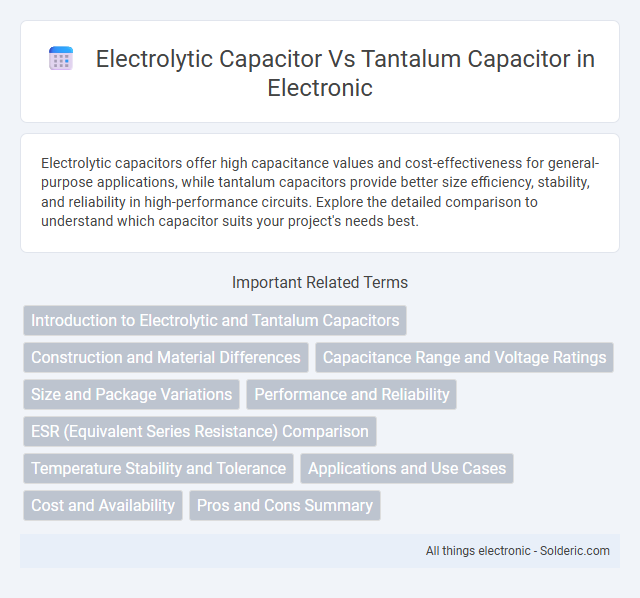Electrolytic capacitors offer high capacitance values and cost-effectiveness for general-purpose applications, while tantalum capacitors provide better size efficiency, stability, and reliability in high-performance circuits. Explore the detailed comparison to understand which capacitor suits your project's needs best.
Comparison Table
| Feature | Electrolytic Capacitor | Tantalum Capacitor |
|---|---|---|
| Dielectric Material | Aluminum oxide | Tantalum pentoxide |
| Capacitance Range | 1 uF to 1,000,000 uF | 0.1 uF to 470 uF |
| Voltage Rating | Up to 500V | Typically up to 50V |
| Size | Larger, bulkier | Smaller, compact |
| ESR (Equivalent Series Resistance) | Higher ESR | Lower ESR |
| Reliability | Lower, prone to leakage and drying out | Higher, more stable over time |
| Polarity | Polarized | Polarized |
| Cost | Lower cost | Higher cost |
| Typical Applications | Power supply filtering, bulk energy storage | Precision filtering, timing circuits, space-constrained designs |
Introduction to Electrolytic and Tantalum Capacitors
Electrolytic capacitors utilize an electrolyte to achieve high capacitance values in a compact form, making them ideal for power supply filtering and audio applications. Tantalum capacitors, constructed with a tantalum metal anode, offer superior stability, lower equivalent series resistance (ESR), and enhanced reliability in space-constrained circuits. Both capacitor types provide polarized designs but differ significantly in performance characteristics, cost, and failure modes.
Construction and Material Differences
Electrolytic capacitors utilize an aluminum foil anode coated with an oxide layer as the dielectric, combined with a liquid or solid electrolyte to achieve high capacitance values, making them suitable for power supply filtering and energy storage. Tantalum capacitors feature a tantalum metal anode with a sintered powder structure, covered by a thin tantalum oxide dielectric and a solid manganese dioxide or conductive polymer electrolyte, resulting in higher stability and reliability in compact sizes. Your choice between these capacitors depends on factors like voltage rating, capacitance, size constraints, and required performance, influenced by their distinct materials and construction principles.
Capacitance Range and Voltage Ratings
Electrolytic capacitors typically offer a broad capacitance range from 1 uF to 47,000 uF with voltage ratings up to 450V, making them ideal for high-capacitance, low-voltage applications. Tantalum capacitors generally provide capacitance values between 0.1 uF and 1,000 uF, with voltage ratings commonly ranging from 6.3V to 50V, suited for compact, stable, and lower-voltage circuits. The choice between these capacitors depends on required capacitance size, voltage tolerance, and size constraints.
Size and Package Variations
Electrolytic capacitors typically offer larger sizes and a wide range of package variations, making them suitable for high-capacitance and high-voltage applications where space is less constrained. Tantalum capacitors, on the other hand, provide smaller, more compact packages with stable capacitance and lower equivalent series resistance (ESR), ideal for space-sensitive and high-reliability circuit designs. When selecting the right capacitor for your project, consider tantalum capacitors if minimizing size and maximizing performance in compact layouts is critical.
Performance and Reliability
Electrolytic capacitors offer high capacitance values and cost-efficiency but exhibit lower reliability under high temperature and voltage stress, leading to shorter lifespans and increased leakage current. Tantalum capacitors provide superior performance through stable capacitance, low equivalent series resistance (ESR), and excellent reliability in demanding conditions, such as high temperature and frequency applications. Their hermetic sealing and robust oxide layer minimize failure rates, making them preferred for critical electronics requiring long-term stability.
ESR (Equivalent Series Resistance) Comparison
Tantalum capacitors typically exhibit lower Equivalent Series Resistance (ESR) than electrolytic capacitors, enhancing their efficiency in high-frequency applications. The reduced ESR in tantalum capacitors results in lower energy loss and improved thermal performance, which is critical for sensitive electronic circuits. Electrolytic capacitors, while generally higher in ESR, offer larger capacitance values at a lower cost but may generate more heat under high ripple current conditions.
Temperature Stability and Tolerance
Tantalum capacitors exhibit superior temperature stability with minimal capacitance variation across a wide temperature range, typically from -55degC to +125degC, making them ideal for demanding applications. Electrolytic capacitors generally have wider tolerance levels, commonly +-20%, and their performance can degrade significantly at elevated temperatures beyond 85degC, leading to reduced lifespan and capacitance drift. The tight tolerance and enhanced stability of tantalum capacitors contribute to their preference in precision circuits requiring consistent performance under thermal stress.
Applications and Use Cases
Electrolytic capacitors are widely used in power supply filtering, audio equipment, and motor start circuits due to their high capacitance and voltage ratings at a low cost. Tantalum capacitors are preferred in space-constrained applications such as mobile devices, aerospace electronics, and medical implants because of their stable capacitance, reliability, and low equivalent series resistance (ESR). Both types serve critical roles in smoothing voltage fluctuations, but tantalum capacitors excel in precision and long-term performance under harsh conditions.
Cost and Availability
Electrolytic capacitors typically offer lower cost and higher availability compared to tantalum capacitors, making them a popular choice for cost-sensitive applications. Tantalum capacitors, while more expensive due to their superior performance characteristics, often face supply constraints and longer lead times. Your project's budget and timeline play a crucial role in deciding between these two capacitor types.
Pros and Cons Summary
Electrolytic capacitors offer high capacitance values at a lower cost but have limited lifespan and lower stability under high temperatures compared to tantalum capacitors. Tantalum capacitors provide better reliability, lower equivalent series resistance (ESR), and superior performance in smaller sizes, yet they are more expensive and sensitive to voltage spikes. Your choice depends on application requirements balancing cost, size, stability, and durability.
electrolytic capacitor vs tantalum capacitor Infographic

 solderic.com
solderic.com